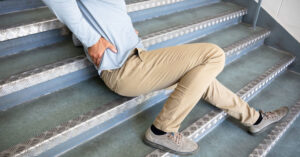Why the Elderly Are Especially Prone to Falls
 As we age, the risk of falling increases significantly. Falls are a major health concern for the elderly, often leading to serious injuries, hospitalization, and even death. Understanding the factors that contribute to this increased susceptibility is crucial for preventing falls and maintaining the independence and quality of life of older adults.
As we age, the risk of falling increases significantly. Falls are a major health concern for the elderly, often leading to serious injuries, hospitalization, and even death. Understanding the factors that contribute to this increased susceptibility is crucial for preventing falls and maintaining the independence and quality of life of older adults.
Age-Related Physiological Changes
Decreased Muscle Strength and Flexibility
One of the primary reasons why the elderly are more prone to falls is the natural decline in muscle strength and flexibility that occurs with aging. As we grow older, our muscles tend to lose mass and strength, a condition known as sarcopenia. This muscle weakness can make it more difficult to maintain balance, especially during activities that require quick movements or changes in position. Furthermore, the joints and connective tissues become less flexible over time, limiting the range of motion and increasing the risk of falls due to impaired mobility and stability.
Sensory Impairments
Age-related sensory impairments, such as vision and hearing loss, can also contribute to an increased risk of falls among the elderly. Poor vision can make it difficult to detect obstacles, judge distances, and navigate through different environments. Hearing loss, on the other hand, can affect an individual’s ability to maintain balance and spatial awareness, as the inner ear plays a crucial role in our sense of equilibrium.
Neurological Changes
As we age, our brains undergo changes that can affect our cognitive abilities, reflexes, and coordination. Conditions like dementia, Parkinson’s disease, and stroke can impair an individual’s judgment, decision-making skills, and reaction time, all of which can increase the likelihood of falls.
Environmental Factors
Hazards in the Home
Many falls among the elderly occur within the home environment. Cluttered living spaces, poor lighting, loose rugs or carpets, and lack of grab bars or handrails in bathrooms and stairways can all contribute to an increased risk of falls. Additionally, the use of certain medications or the presence of medical conditions, such as dizziness or incontinence, can further exacerbate the risk of falls in the home setting.
Outdoor Obstacles
Outdoor environments can also pose challenges for the elderly. Uneven surfaces, cracks in sidewalks, curbs, and inclement weather conditions (such as rain, snow, or ice) can increase the likelihood of slips and falls. Additionally, poor lighting in public areas or the presence of obstacles like construction sites or poorly maintained walkways can create hazardous situations for older adults.
Medication Side Effects
Many older adults take multiple medications to manage various health conditions. However, some of these medications can have side effects that increase the risk of falls. For example, certain blood pressure medications, antidepressants, and sedatives can cause dizziness, drowsiness, or impaired coordination, all of which can contribute to an increased risk of falling.
Chronic Health Conditions
Chronic health conditions, such as arthritis, diabetes, and heart disease, can also play a role in the increased susceptibility to falls among the elderly. These conditions can affect mobility, balance, and overall physical function, making it more difficult to maintain stability and avoid falls.
Additionally, conditions like osteoporosis, which causes weakened bones, can increase the risk of serious fractures if a fall does occur.
Prevention Strategies
Regular Exercise and Physical Activity
Engaging in regular exercise and physical activity can help maintain muscle strength, flexibility, and balance, all of which are crucial for fall prevention. Low-impact exercises like walking, swimming, or tai chi can be particularly beneficial for older adults. Additionally, incorporating strength training and balance exercises into a regular routine can improve overall physical function and reduce the risk of falls.
Home Safety Assessments and Modifications
Conducting a thorough home safety assessment and making necessary modifications can significantly reduce the risk of falls within the home environment. This may include removing clutter, installing grab bars and handrails, improving lighting, securing loose rugs or carpets, and ensuring clear pathways throughout the living space.
Medication Review and Management
Regular medication reviews with a healthcare provider can help identify potential side effects or interactions that may increase the risk of falls. In some cases, adjusting dosages or exploring alternative treatment options may be necessary to minimize fall-related risks.
Use of Assistive Devices
Assistive devices, such as canes, walkers, or mobility scooters, can provide additional stability and support for older adults, reducing the risk of falls. It’s essential to ensure that these devices are properly fitted and used correctly to maximize their effectiveness.
Vision and Hearing Assessments
Regular vision and hearing assessments can help identify and address any sensory impairments that may contribute to an increased risk of falls. Proper treatment, such as corrective lenses or hearing aids, can improve overall safety and mobility for older adults.
Community Resources and Support
Many communities offer fall prevention programs, exercise classes, and support services specifically designed for older adults. Participating in these resources can provide valuable education, guidance, and practical strategies for reducing the risk of falls and promoting independence.
Conclusion
Falls among the elderly are a significant public health concern, often leading to serious injuries, decreased mobility, and a loss of independence. By understanding the various factors that contribute to this increased susceptibility, such as age-related physiological changes, environmental hazards, medication side effects, and chronic health conditions, we can develop effective prevention strategies.
Regular exercise, home safety assessments, medication management, and the use of assistive devices can all play a crucial role in reducing the risk of falls and improving the overall well-being of older adults. Additionally, seeking support from community resources and healthcare professionals can provide valuable guidance and support throughout the fall prevention process.
It’s important to note, however, that not all falls are blame free. If an elderly loved one has been involved in a slip and fall accident that wasn’t their fault, contact the law firm of Pardy & Rodriguez for more information and assistance. We can help determine whether somebody else was at fault and help you claim compensation for your costs. You can visit our offices at:
- Orlando – 315 Park Lake Cir., Orlando, FL 32803
- Tampa – 11700 N. 58th St., Ste. A, Temple Terrace, FL 33617
- Kissimmee – 1052 E. Osceola Parkway, Kissimmee, FL 34744
- Poinciana – 4663 Old Pleasant Hill Road, Poinciana, FL 34759
- Davenport – 40230 US Highway 27, Suite 140, Davenport, FL 33837
- Bradenton – 409 6th Avenue East, Bradenton, FL 34208
Or call now for a free consultation on (888) 522-0222.


